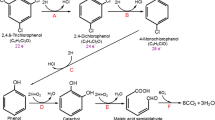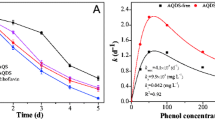Abstract
Relatively low concentrations of Vitamin B12 are known to accelerate the anaerobic biotransformation of carbon tetrachloride (CT) and chloroform (CF). However, the addition of vitamin B12 for field-scale bioremediation is expected to be costly. The present study considered a strategy to generate vitamin B12 by addition of biosynthetic precursors. One of the precursors, porphobilinogen (PB) involved in the formation of the corrin ring, significantly increased the CT biotransformation rates by 2.7−, 8.8- and 10.9-fold when supplemented at 160, 500 and 900 μM, respectively. A positive control with 10 μM of vitamin B12 resulted in a 5.9-fold increase in the CT-bioconversion rate. PB additions provided high molar yields of inorganic chloride (57% of CT organochlorine), comparable to that obtained with vitamin B12 supplemented cultures. The primary substrate, methanol, known to induce vitamin B12 production in methanogens and acetogens, was required for PB to have a significant impact on CT conversion. The observation suggests that PB’s role was due to stimulating vitamin B12 biosynthesis. The present study therefore provides insights on how to achieve vitamin B12 enhanced rates of CT bioremediation through the use of less complex compounds that are precursors of vitamin B12. Although PB is a costly chemical, its large impact points to corrin ring formation as the rate-limiting step.
Similar content being viewed by others
Abbreviations
- CNB12 :
-
cyanocobalamin
- PB:
-
porphobilinogen
- VFA:
-
volatile fatty acids
- CT:
-
carbon tetrachloride
- CF:
-
chloroform
- VSS:
-
volatile suspended solids
- COD:
-
chemical oxygen demand
References
Assafanid N, Hayes KF, Vogel TM, 1994 Reductive dechlorination of carbon-tetrachloride by cobalamin(ii) in the presence of dithiothreitol – mechanistic study, effect of redox potential and pH Environ. Sci. Technol. 28: 246–252
Battersby AR, Leeper FJ, 1998 Biosynthesis of vitamin B-12 Biosynthesis. 195: 143–193
Becker JG, Freedman DL, 1994 Use of Cyanocobalamin to enhance anaerobic biodegradation of chloroform Environ. Sci. Technol. 28:1942–1949
Burris DR, Delcomyn CA, Smith MH, Roberts AL, 1996 Reductive dechlorination of tetrachloroethylene and trichloroethylene catalyzed by vitamin B-12 in homogeneous and heterogeneous systems Environ. Sci. Technol. 30: 3047–3052
Cervantes FJ, Vu-Thi-Thu L, Lettinga G, Field JA, 2004 Quinone-respiration improves dechlorination of carbon tetrachloride by anaerobic sludge Appl. Microbiol. Biotechnol. 64: 702–711
Egli C, Stromeyer S, Cook AM, Leisinger T, 1990 Transformation of tetrachloromethane and trichloromethane to carbon dioxide by anaerobic bacteria is a non-enzymic process FEMS Microbiol. Lett. 68: 207–212
Egli C, Tschan T, Scholtz R, Cook AM, Leisinger T, 1988 Transformation of tetrachloromethane to dichloromethane and carbon-dioxide by Acetobacterium woodii Apple Environ. Microbiol. 54: 2819–2824
Field JA & Sierra-Alvarez R (2004) Biodegradability of chlorinated solvents and related chlorinated aliphatic compounds. Re/Views Environ. Sci. Bio/Technol. 3: 185–254
Fonseca MV, Escalante-Semerena JC, 2000 Reduction of cob(III)alamin to cob(II)alamin in Salmonella enterica serovar typhimurium LT2 J. Bacteriol. 182: 4304–4309
Gantzer CJ, Wackett LP, 1991 Reductive dechlorination catalyzed by bacterial transition-metal coenzymes Environ. Sci. Technol. 25: 715–722
Glod G, Angst W, Holliger C, Schwarzenbach RP, 1997a Corrinoid-mediated reduction of tetrachloroethene, trichloroethene, and trichlorofluoroethene in homogeneous aqueous solution: reaction kinetics and reaction mechanisms Environ. Sci. Technol. 31: 253–260
Glod G, Brodmann U, Angst W, Holliger C, Schwarzenbach RP, 1997b Cobalamin-mediated reduction of cis- and trans-dichloroethene, 1,1-dichloroethene, and vinyl chloride in homogeneous aqueous solution: reaction kinetics and mechanistic considerations Environ. Sci. Technol. 31: 3154–3160
Guerrero-Barajas C, Field JA, 2005a Enhancement of anaerobic carbon tetrachloride biotransformation in methanogenic sludge with redox active vitamins Biodegradation 16: 215–228
Guerrero-Barajas C, Field JA, 2005b Riboflavin- and cobalamin-mediated biodegradation of chloroform in a methanogenic consortium Biotechnol. Bioeng. 89: 539–550
Harms U, Thauer RK, 1996 Methylcobalamin:coenzyme M methyltransferase isoenzymes MtaA and MtbA from Methanosarcina barkeri – cloning, sequencing and differential transcription of the encoding genes, and functional overexpression of the mtaA gene in Escherichia coli Eur. J. Biochem. 235: 653–659
Hashsham SA, Freedman DL, 1999 Enhanced biotransformation of carbon tetrachloride by Acetobacterium woodii upon addition of hydroxocobalamin and fructose Appl. Environ. Microbiol. 65: 4537–4542
Hashsham SA, Scholze R, Freedman DL, 1995 Cobalamin-enhanced anaerobic biotransformation of carbon-tetrachloride Environ. Sci. Technol. 29: 2856–2863
Krone UE, Thauer RK, Hogenkamp HPC, 1989 Reductive dehalogenation of chlorinated C1-hydrocarbons mediated by corrinoids Biochemistry 28: 4908–4914
Krone UE, Thauer RK, Hogenkamp HPC, Steinbach K, 1991 Reductive formation of carbon-monoxide from CCl4 and freon-11, freon-12, and freon-13 catalyzed by corrinoids Biochemistry 30: 2713–2719
Lebloas P, Loubiere P, Lindley ND, 1994 Use of unicarbon substrate mixtures to modify carbon flux improves vitamin-B12 production with the acetogenic methylotroph Eubacterium limosum Biotechnol. Lett. 16: 129–132
Lesage S, Brown S, Millar K, 1998 A different mechanism for the reductive dechlorination of chlorinated ethenes: kinetic and spectroscopic evidence Environ. Sci. Technol. 32: 2264–2272
Lexa D, Saveant JM, 1983 The electrochemistry of vitamin-B12 Acc. Chem. Res. 16: 235–243
Lin DG, Nishio N, Mazumder TK, Nagai S, 1989 Influence of Co2+, Ni2+ and Fe2+ on the production of tetrapyrroles by Methanosarcina barkeri App1. Microbiol. Biotechnol. 30: 196–200
Martens JH, Barg H, Warren MJ, Jahn D, 2002 Microbial production of vitamin B-12 Appl. Microbiol. Biotechnol. 58: 275–285
Mazumder TK, Nishio N, Fukuzaki S, Nagai S, 1987 Production of extracellular vitamin-B12 compounds from methanol by Methanosarcina barkeri Appl. Microbiol. Biotechnol. 26: 511–516
Neujahr HY, Callieri DA, 1959 On vitamins in sewage sludge. 9. Production of vitamin-B12 by methane bacteria Acta Chem. Scand. 13: 1453–1459
Nishio N, Yano T, Kamikubo T, 1975 Isolation of methanol-utilizing bacteria and its vitamin-B12 production Agric. Biol. Chem. 39: 21–27
Raux E, Schubert HL, Warren MJ, 2000 Biosynthesis of cobalamin (vitamin B-12): a bacterial conundrum Cell. Mol. Life Sci. 57: 1880–1893
Roth JR, Lawrence JG, Bobik TA, 1996 Cobalamin (coenzyme B-12): Synthesis and biological significance Annu. Rev. Microbiol. 50: 137–181
Sipma J, Lens PNL, Stams AJM, Lettinga G, 2003 Carbon monoxide conversion by anaerobic bioreactor sludges FEMS Microbiol. Ecol. 44: 271–277
Stupperich E, Aulkemeyer P, Eckerskorn C, 1992 Purification and characterization of a methanol-induced cobamide-containing protein from Sporomusa ovata Arch. Microbiol. 158: 370–373
Toraya T, Yongsmith B, Tanaka A, Fukui S, 1975 Vitamin-B12 production by a methanol-utilizing bacterium Appl. Microbiol. 30: 477–479
Van Der Meijden P, Te Brommelstroet BW, Poirot CM, Van Der Drift C & Vogels GD (1984a) Purification and properties of methanol 5-hydroxybenzimidazolylcobamide methyltransferase from Methanosarcina barkeri. J. Bacteriol. 160: 629–635
Van Der Meijden P, Van Der Drift C & Vogels GD (1984b) Methanol conversion in Eubacterium limosum. Arch. Microbiol. 138: 360–364
Van Eekert MHA, Schroder TJ, Stains AJM, Schraa G, Field JA, 1998 Degradation and fate of carbon tetrachloride in unadapted methanogenic granular sludge Appl. Environ. Microbiol. 64: 2350–2356
van Eekert MHA, Stains AJM, Field JA, Schraa G, 1999 Gratuitous dechlorination of chloroethanes by methanogenic granular sludge Appl. Microbiol. Biotechnol. 51: 46–52
Warren MJ, Raux E, Schubert HL, Escalante-Semerena JC, 2002 The biosynthesis of adenosylcobalainin (vitamin B-12) Nat. Product Rep. 19: 390–412
Workman DJ, Woods SL, Gorby YA, Fredrickson JK, Truex MJ, 1997 Microbial reduction of vitamin B-12 by Shewanella alga strain BrY with subsequent transformation of carbon tetrachloride Environ. Sci. Technol. 31: 2292–2297
Zou SW, Stensel HD, Ferguson JF, 2000 Carbon tetrachloride degradation: Effect of microbial growth substrate and vitamin B-12 content Environ. Sci. Technol. 34: 1751–1757
Acknowledgements
The research was funded in part through a scholarship (Guerrero-Barajas) from the Mexican Ministry of Science and Technology (CONACyT). The authors are also grateful to Crystal Vargas for experimental assistance.
Author information
Authors and Affiliations
Corresponding author
Rights and permissions
About this article
Cite this article
Guerrero-Barajas, C., Field*, J.A. Enhanced anaerobic biotransformation of carbon tetrachloride with precursors of vitamin B12 biosynthesis. Biodegradation 17, 317–329 (2006). https://doi.org/10.1007/s10532-005-9001-2
Accepted:
Published:
Issue Date:
DOI: https://doi.org/10.1007/s10532-005-9001-2




